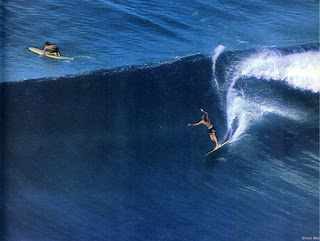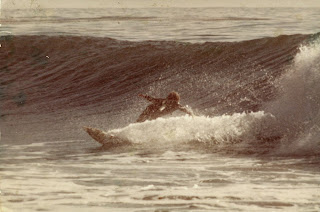Sunday, July 27, 2008
OK I’m cynical, when Clark shut his doors that impacted the industry over night… in a big way. But the cost of oil? The cost of living? That affects everything, and it happens over time. So what… us surf guys are exempt? No, but hey that’s news.
It was just a month ago when we were told at the shop by our supplier that the price of Acetone was going up 4 bucks a pale. I said “geez that’s kind of plenty, I remember when I could get a whole pale for less than 4 bucks” His response… “ yeah, well what do you expect? You’re as old as dirt”
Reality, the cost of making a surfboard has been going up pretty steady for a number of years, like 40 years or more. Just like everything else. Right now though the cost of supplies is rising at a faster pace. But, the cost of gas is affecting everything. And because we all use gas for transportation and the price of gas has gotten so high, for those of us that make surfboards, it will be our personal cost of living that will impact the cost of a surfboard probably much more than a couple bucks for supplies… we need more money to live on so we need to charge more for our time to make a surfboard… but that’s not news.
When I went down to San Clemente in June I spent $62 on gas for the trip. The cost of taking Amtrak from Ventura to San Clemente is $32 one way. I could have gone down and back on the train and been better off. I went alone, but if I had someone else with me or I went with someone else it would have cost us half that $62 each in the car. So is that what everyone is doing, instead of driving to the beach by themselves they partner up with other guys so the cost of gas for getting to the beach to surf is shared? ’ cause it seems to me that the line up is just as crowded as ever. But hey, that’s not news either.
D.R.
Sunday, July 20, 2008
If you think about the way we surfed, and for that matter what we surf, changed pretty radically in just those few years from 1967 to ‘70 - ‘71. As I mentioned in my post of July 6, for me it started with the bottom turn.
Looking for a way to ride a wave without moving around on your board was what drove board design. Interesting that all the changes took place on a very grass roots level. There were no big pro surf events, no big sponsors that put good surfers on the payroll so all they had to do was surf. There were a couple surf magazines and some guys making surf films so we all could see a little of what was going on but, the advances in surfing around California was put on by all the local core guys up and down the coast that did what they needed to do to get by and still have time to surf as much as possible.
I think most people didn’t understand the surfer. We weren’t interested in making money or getting ahead. We just wanted to go surf. Got to have a roof over your head and you need transportation, so find some work that will get you that and a surfboard, of course, and that’s it… go surf.
Why? We wanted to work on that bottom turn. You know the one that you put all your weight into, with your board on extreme bank out on the flats. You’ve got full G force dynamic with weight, gravity, rail, fin and water that when released launches you down the line and back up the wave face to set up your next move. It could be a ride out on the shoulder for a turn back or a long calculated slide down the line for distance. One way or another you’d be looking to set up another bottom turn. When your ride was over… paddle back to the line up with full adrenaline and mind impressions flashing through your head of that last wave. Ready to do it all over again, only better.
All the uncharted places on the wave face that starts with a bottom turn…
D.R.
Sunday, July 13, 2008
The man and his Machine.
I received a phone call Thursday from someone that said they’d like me to see a surfboard they had and maybe consider doing some repairs on it. The board has been in this person’s possession for some 35 years though the board was made 41 years ago in 1967.
So I said “ sure “ to the person on the phone “ bring your board by the shop and I’ll have a look.” Ten minuets later John appears at the shop door. We greet each other then he runs back to his vehicle and brings back the nicest looking Blue Machine I’d seen in a long time. Aside from some of the Slip Check being a little worn on the tip of the nose the deck looked perfect. The bottom had some dings and the rails at the tail where worn through from being dragged in the sand. The fin had been replaced with a fresh polypropylene fin including wonder bolt. But hey, when you surf a board it will get some battle scars, all things considered…. it was a fine looking board. I honestly didn’t remember the Blue Machines being so nicely foiled. It felt so nice under my arm I had to take it into my shaping bay and take some measurements.
So how’s this for a 41 year old….? At 9’4” and 23” wide, all of 2 ¾ “ thick with a 16 ¾” nose and 15” tail. Rolled up rails in the tail that went to a nice 50/50 egg shape then on to the wing tip nose. The only difference between it and the Machines I make now was the roll under the nose which I make flat now and the nose rocker, which was some what lower than I do now but, the tail rocker was exactly what I do now.
The history, the times long gone, but the memories are still here. I was so fortunate to have been there.
D.R.
 John and his Machine.
John and his Machine.
Sunday, July 06, 2008
My story post 32. It started with a bottom turn.
What I remember about getting good surf in the summer of ’67 is the length of my board. Even though I surfed a 9’0, which was short by most standards it began to feel to long.
What was nice about surfing that day with ‘Pee Wee’ Shaw... with every wave I looked forward to working on bottom turns. Back then we usually executed a pivot type turn where you’d step back on you board weight your back foot and guide your board around with you front foot. The popular left go right turn was done that way.
After executing your turn you would immediately take a couple steps to put yourself in trim. If you didn’t move forward you’d stall off the wave, so a quick reposition after your turn was mandatory. Reach, shuffle or step back, turn and step forward was a pretty automatic move after standing up.
Riding mostly point waves I started finding that after the initial turn and glide down the line and dropping back down the wave face and pointing your board at a slight angle to the wave, you could execute another bottom turn from the middle of your board. By laying the board over on its rail and at the same time weighting into the move with a full arched back stand rather than stepping back . The move generated speed so worked great on a lined up wall.
So on days with really good surf like that one day in ’67 I would work on that bottom turn time and again wave after wave until what I began to think was that the move would be easier if I didn’t have as much surfboard under my feet. If I didn’t need to step back to execute a turn why not have a board that was shorter so there was no need to step back?
Though later the next year guys were taking their long boards and cutting off the noses to make them shorter, the design process was actually the other way around… at least for me. It wasn’t that the boards were to long in front, they were to long aft. I didn’t want to step back to turn, I wanted to stand up and turn right where I planted my feet on take off. As well, you might notice that the early shorter boards, from
D.R.
 This shot of Dickie Moon from an old Surfer Magazine I nicked off of Swaylocks is a fairly close example of the stand in the middle of your board turn.
This shot of Dickie Moon from an old Surfer Magazine I nicked off of Swaylocks is a fairly close example of the stand in the middle of your board turn.